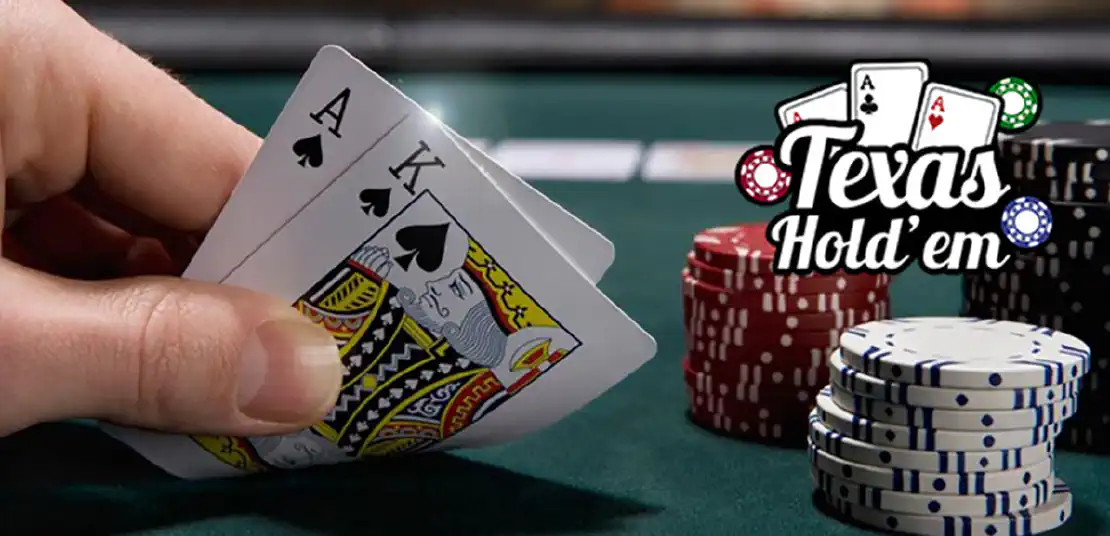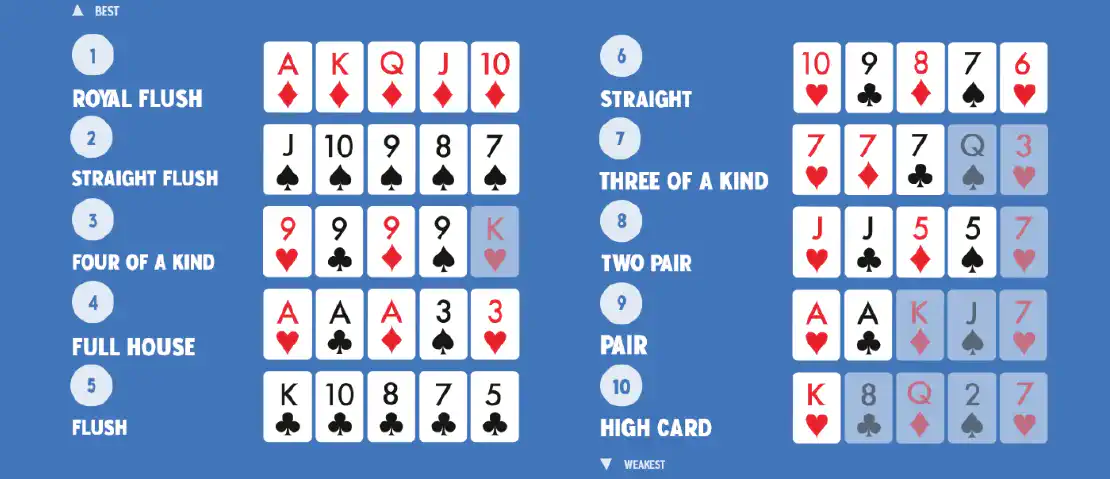Texas Hold'em - poker game. Texas Hold'em tactics and hands
New Slots Included
Large selection of bonuses
Сan bet on sports
Jackpot Alerts
Over 300 Slots
Made For Mobile
Island Jackpots - Casino UK. New players only. 100% Up To, Min deposit £200, Welcome Bonus. Year of foundation 2017. License Gambling Commission (UKGC). 18+ Please Gamble Responsibly. Click 'Claim Bonus' to view the full terms and conditions.
Updated: 2024.03.12
Ah, Texas Holdem. Ever been to a Friday night poker game and felt that tingling sense of excitement when you’re dealt those two cards? The anticipation, the strategy, the bluffing - it’s a game of intellect, psychology, and a dash of luck. But what’s the story behind this popular card game? And how exactly do you play it? Let’s discover it with InscribeMedia!

History of Texas Hold’em
Believe it or not, the roots of Texas Holdem can be traced back to the early 1900s in Robstown, Texas. From there, it traveled to Las Vegas in the 1960s, and today? It’s the crown jewel of poker games at online casinos. Who would’ve thought?
Basics of the Game
Omaha, Live Poker and Texas Hold’em are both popular poker variants, but they differ primarily in the number and usage of hole cards: Omaha players receive four hole cards but must use exactly two in combination with three of the five community cards to form a hand, while Texas Hold’em players get two hole cards and can use any combination of five cards for their hand. Omaha often features more complex scenarios due to more starting card combinations, whereas Texas Hold’em is globally more popular and is widely recognized in its No Limit format.
Before diving into the nitty-gritty, let’s break down the basics.
The Deck & Cards
Using a standard deck of 52 cards, the aim is simple: combine your two private cards (known as ‘hole cards’) with the five community cards on the table to make the best five-card hand.
Betting Structure
In Texas Holdem, you’ll encounter terms like ‘big blind’, ‘small blind’, and ‘ante’. Sound Greek to you? Well, these are just forced bets to kickstart the game.
Player Objective
Your goal? To win chips. This can be achieved either by having the best hand during the showdown or convincing other players to fold their hands. In the world of Texas Holdem, strategy and bluffing often triumph over having the best cards.
Table Etiquette
Whether you’re a newbie or a seasoned pro, remember to be respectful. Wait for your turn, pay attention, and no “angle shooting” (using tactics to deceive players). Poker’s not just about winning; it’s about enjoying the game and respecting your fellow players.
Texas Hold’em Poker Rules

Now, let’s pick up where we left off on those all-important rules.
Pre-Flop
After those initial blinds are posted, each player gets dealt two private ‘hole’ cards, face down. Here’s where the mental gymnastics start. Based on your cards, you’ll decide whether to fold, call, or raise. It’s a crucial decision point. Do you feel lucky or strategic?
The Flop
The dealer then places three community cards face-up on the board. These cards are available to all players for creating their best hand. At this stage, you’ll probably start building a narrative. Are those community cards helping your hand, or are you banking on what’s to come?
The Turn
Then comes the turn card, a fourth community card placed face-up. It’s another chance to form that winning hand. It also means only one more community card to come. Can you feel the tension building?
The River
This is the big reveal, the fifth and last community card. Now, it’s time for the final round of betting. All the cards are on the table, both literally and metaphorically. So, are you in or out?
Showdown
It’s showtime! Players still in the game reveal their hands. The one holding the best hand wins the pot. But remember, the best strategists often leave with the winnings even if they don’t have the best cards. It’s all in the play.
Texas Hold’em Hands
The bedrock of any Texas Holdem game lies in understanding the value of hands. Recognizing these hand rankings and knowing how they stack up against each other can be the difference between folding too early or riding a weak hand too long.

Ranking of Texas Hold em hands rank
- High Card: If no player has a form of a pair or any other higher-ranking hand, the highest card wins. It’s not an enviable position but can occasionally snag you the pot in a tight game.
- One Pair: Two cards of identical rank. Even a low pair can dominate a game if others have even lesser hands.
- Two Pairs: Holding two distinct pairs, like 8s and 5s. Solid, but always be wary of the board and potential higher hands.
- Three of a Kind: Three cards of the same rank. If you’re holding this, you’re probably feeling pretty good about your chances.
- Straight: Five consecutive cards of any suit. A versatile hand that can often fly under the radar.
- Flush: Five cards of the same suit, but not in sequence. A sneaky powerful hand that can often surprise opponents.
- Full House: A combination of three of a kind and a pair. A very dominant hand in most games.
- Four of a Kind: Four cards of the same rank. If you have this, it’s time to strategize about maximizing your win.
- Straight Flush: Five consecutive cards, all of the same suit. The stuff dreams are made of.
- Royal Flush: Ace, King, Queen, Jack, and 10, all of the same suit. The pinnacle of Texas Holdem hands. If you’re holding this, treasure the moment!
Texas Holdem tactics
While the hierarchy of the hands is relatively straightforward, playing them requires nuance. For instance:
- A Pair in your hole cards is powerful but can be easily overshadowed by the community cards.
- Holding a high card, like an Ace or a King, might make you feel confident pre-flop, but it’s essential to see how the community cards support your hand. An Ace-high hand isn’t always the winning ticket!
- Always be mindful of potential Straights and Flushes on the board. Recognizing these possibilities can help you avoid pitfalls or exploit your opponents.
Tips for Playing Your Hand
- Be Observant: Always keep an eye on the community cards. They might complete your hand or give someone else an advantage.
- Know When to Fold: Holding onto a mediocre hand, hoping it’ll improve, can be a costly mistake.
- Position Matters: Being the last to act can give you valuable insights into your opponents’ potential hands based on their actions.
By understanding the intricacies of Texas Holdem hands, not just their ranks but also how to play them, you stand a better chance of navigating the challenges and coming out on top.
Conclusion
Texas Holdem isn’t just a card game casino; it’s a game of wit, courage, and strategy. Whether you’re playing for fun with friends or competing in the World Series of Poker, remember: it’s not about the cards you’re dealt, but how you play them.
FAQ
How often is the Royal Flush dealt in Texas Hold’em?

Ah, the Royal Flush. It’s the holy grail of Texas Holdem hands, and with good reason. The odds of being dealt a Royal Flush are a staggering 1 in 649,739! It’s so rare that many seasoned players have never seen one in their entire poker-playing careers. To put it into perspective, you’re more likely to be struck by lightning or win an Olympic medal than get dealt this unbeatable hand. But if you ever do, enjoy the bragging rights!
Is 'bluffing' a valid strategy?

Absolutely, but it’s more art than science. Bluffing is the psychological side of poker. It’s about convincing other players you have a stronger hand than you actually do. But it comes with risks. Bluff too often, and your opponents might catch on, calling your bluff and causing you to lose chips. On the flip side, if you’re too predictable and never bluff, seasoned players will read you like an open book. A successful bluff can be incredibly rewarding, not just in terms of winning chips but also in the psychological edge it gives you.
What's the best position to be in at the Texas Holdem poker table?

Poker is as much about strategy as it is about the cards, and position plays a pivotal role. Many players argue that the ‘button’ position is the most advantageous. Why? Because being on the button means you act last in each betting round. This gives you the advantage of seeing how all other players act before making your decision. It offers insight into their potential hands and strategies, allowing you to adjust your gameplay accordingly. Being last can often be the best in Texas Holdem poker.
How many people can play Texas Hold'em?

From two to ten people can play Texas Hold’em. In this case, depending on the number of the maximum number of participants, the game tables can be: - Long (9-10 players - 9-max or 10-max).


